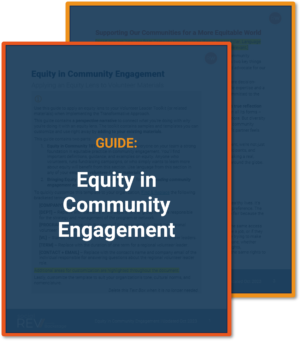Corporate Social Impact programs benefit our communities, engage our employees, and demonstrate company values internally and publicly. Employee volunteering and giving can be, we believe, the perfect vehicles to achieve the “triple bottom line.”
But truly effective programs require more than donations and volunteering. They require an approach to equity that challenges assumptions and transforms perspectives.
If we want real impact, we need to incorporate equity. We need to challenge the systems that marginalize, silence, and harm people, and we need to lift up the voices that are often ignored because historically they haven’t held as much power.
Thinking equitably will make your programs stronger and more meaningful for your communities and the nonprofits that serve them, for your employees, and for your colleagues in the field. Yes, it means tough conversations and re-evaluating processes you built. You’ll make well-intentioned mistakes. Opinions will clash over the right path. But truth-telling, humility, and willingness to change are what communities need from corporate partners like you. This blog shares four steps you can take toward equity in corporate Social Impact.

EQUITY IN COMMUNITY ENGAGEMENT GUIDE
Use this guide to apply an equity lens to your Volunteer Leader Toolkit (or related materials) when implementing the Transformative Approach. The toolkit contains samples and templates you can customize and use right away by adding to your existing materials.
Bring Equity into Corporate Social Impact Mission Statements
Equity must be an explicit part of a company’s Social Impact mission. While words like “citizenship” evoke ideals of community support, equity is often assumed rather than stated.
When we talk about Corporate Social Impact, Social Responsibility, Citizenship, or Community Investment, we’re inherently talking about equity. We’re talking about making our communities stronger and healthier. We’re talking about making companies’ practices beneficial to people and the Earth while still achieving business objectives. We need to be sure we’re saying it – out loud.
For example, implicit equity in a mission statement might look like: “Our citizenship strategy aims to build thriving, resilient communities.”
Explicit equity-focused language could state: “Our citizenship strategy aims to build thriving, resilient communities by funding affordable housing, small business grants, and workforce development programs that serve low-income BIPOC neighborhoods.”
Being clear about equity gives focus and meaning to community engagement. It shows both employees and community partners that diversity alone is not the end goal – equity of access, participation, and outcomes for all groups is what matters.
Equity must be a mindset shift that changes how companies operate from the inside out.
Build Employee Competency in Equity and Impact
A critical step towards an equity mindset is ongoing education on core equity concepts and how they show up in volunteering.
Our guide, Equity in Community Engagement: Applying an Equity Lens to Volunteer Materials, explains key concepts like equality vs. equity, systemic inequities, power dynamics, and privilege. This baseline knowledge helps employees at all levels begin to recognize where inequities exist in a community context and how they show up in CSR activities. It helps us see where we’re complicit, regardless of intention.
It is critical for Social Impact teams to focus on how equity concepts function in the work – for leaders setting strategy, program managers designing initiatives, and employee volunteers. Understanding power, privilege, and systemic oppression is mandatory for effective community work – that’s work with our own employee communities and with the broader communities that allow us to partner.
Design Transformative Volunteering Opportunities to Advance Equity
So where does equity show up in Transformative Volunteering?
The guide covers that, too. A few of the tactics included demonstrate:
- How to identify nonprofit and community partners that are also on an equity journey. For example, ask whether programs are thoughtfully designed to be accessible and culturally relevant, and what employee training or community feedback mechanisms are in place to continually improve equitable practices.
- How to collaborate using key questions and allyship principles from the guide as you scope the volunteer project. For example, as you plan a volunteer event with your nonprofit partner, evaluate events and campaigns for accessibility, cultural competence, and inclusive representation. What barriers need addressing? Distribute resources intentionally so they reach underserved groups. How can you direct funds or volunteers where need is greatest?
- How employee volunteers can invite participants to consider the purpose of the event and the assumptions often made about the community, and how to reflect critically on their experience. Employee volunteers can use the scripts in the guide to design a Brief and Debrief for each volunteer event that centers the lived experience of the people and communities they’re supporting, and that recognizes our shared humanity. These simple actions can start to crack the inherent power dynamics that come up in a volunteering context.
How to Continue Your Equity Journey
Integrating equity into corporate Social Impact is an ever-evolving practice, and every organization’s equity journey will look different. But momentum on multiple fronts shows you are progressing on that journey, even as challenges and questions remain.
Social Impact teams have a responsibility to direct some of the enormous resources and influence of large corporations to dismantle systems of oppression.
Corporate Social Impact teams should constantly consider how equity is served in:
- How we talk about community partners and the people they serve
- How we collaborate with community partners
- How we make decisions about how the business and programs are run
- How we write policies and criteria to remove bias and barriers for marginalized groups
- How we track and disclose data such as grantee funding, pay equity metrics, and inclusion survey results
- Whom and when we pay for labor versus expect it for free
- How we recruit, train, engage, and promote employees in their paid and volunteer roles
- How we advocate for communities publicly, through media campaigns and political lobbying
Each individual and team can work directly on some fronts and grow into others.
The inner work to confront biases and assumptions, and the advocacy and labor it takes to move practices and teams forward is incredibly tough. But hang in there. Keep asking, “Who’s left out?” Keep asking, “What are my assumptions about others here?” Make space for community voices. Recruit and train employee volunteer leaders who can help facilitate reflection. Share concepts across your company through “Equity in Corporate Social Impact 101” sessions and training aids, and through simple lessons or workshops. Capture success stories as you build more equitable practices.
Remember, you never have to do this alone—Realized Worth’s guides, tools, and resources (like Social REV) provide what you need to move forward, and our community of corporate Social Impact professionals is committed to shared growth. With support, we can build programs that challenge inequities, not perpetuate them. We’ll see you out there.






